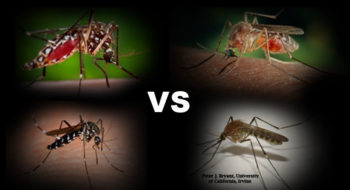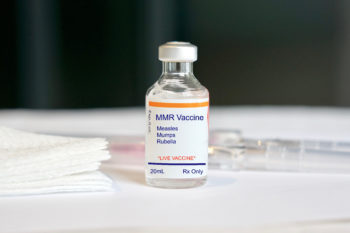Zika is still a threat in San Diego County — especially to pregnant women and women who may become pregnant — and local residents should still be dumping out standing water around homes to fight the invasive Aedes mosquitoes that can potentially transmit Zika.
That’s the message from County of San Diego public and environmental health officials, who are urging county residents to protect themselves as the region moves back into the late-summer, early fall months when the Zika virus made local headlines one year ago.
Between Aug. 19 and Nov. 23 last year, County Vector Control crews hand-sprayed people’s yards in 10 different neighborhoods to kill invasive Aedes mosquitoes to stop them from potentially spreading Zika after they were found living near people who contracted the virus while traveling. Invasive Aedes mosquitoes can only transmit Zika if they first bite a person infected with the virus. No invasive Aedes mosquitoes in San Diego County or California have tested positive for Zika to date.
A year later, Zika headlines have cooled and the numbers of Zika cases appear to be declining in other countries and parts of the U.S., after the virus raced through the Western Hemisphere in 2015.
So far in 2017, nine San Diego County residents have tested as confirmed or probable for Zika, compared to 34 at the same time last year. All of the cases were travel-related, meaning the virus was contracted while traveling outside the U.S.
But County officials said the public should not relax. Even though Zika is not naturally found in our environment — the only cases here are travel-related and no mosquitoes have tested positive for the virus — and eight out of 10 people who become infected never suffer any symptoms, Zika has been linked to the severe birth defect microcephaly, a condition where babies’ heads and brains are smaller than normal.
County officials said this is what local residents need to know and do:
Find and Dump Out Standing Water in and Around Homes
County Vector Control officials said all county residents should look around their homes and yards at least once a week to find and dump out any standing water to make sure invasive Aedes mosquitoes do not have places to breed.
Two types of invasive Aedes mosquitoes that can transmit Zika, chikungunya, dengue and other tropical diseases — if they first bite an infected person — have shown up in San Diego County in recent years.
Aedes aegypti, the yellow fever mosquito, arrived in 2014 and has been found in more and more places around the county since then. Aedes albopictus, the Asian tiger mosquito, showed up in 2015, but its populations remain sparse.
Unlike native mosquito species, these invasive Aedes mosquitoes prefer to live and breed right next to people, in yards and even inside homes. To date, no invasive Aedes mosquitoes have tested positive for Zika in San Diego County or California. But that could happen if mosquitoes are exposed to an infected person.
Invasive Aedes mosquitoes can reproduce in the smallest amounts of water, even in a bottle cap. Water from rain or sprinklers can collect in all kinds of items, including: plant saucers, rain gutters, buckets, garbage cans, old tires, wheelbarrows, even toys. The County’s Vector Control Program gives out mosquitofish for free that can be used to control mosquito breeding in water sources like unused swimming pools, ponds, fountains and horse troughs.
Protect Yourself from Mosquito Bites — Especially Pregnant Women Couples Considering Pregnancy, and People Traveling to Countries with Zika
Hot months are peak mosquito season — not only for invasive Aedes mosquitoes, but for native Culex mosquitoes that can transmit West Nile virus. Residents should protect themselves from being bitten by mosquitoes by taking simple steps. These steps are also especially important for pregnant women, couples thinking about having children and anyone traveling to countries where Zika is established.
- Use insect repellents with DEET, picaridin, IR3535, oil of lemon eucalyptus or para-menthane-diol for long-lasting protection. Pregnant women and women who are breastfeeding should use insect repellents registered with the Environmental Protection Agency and follow directions on the label. Do not use insect repellents on infants under two months of age.
- Wear long-sleeved shirts and pants.
- Keep windows and doors closed if possible and check window and door screens to make sure they don’t have tears or holes.
Check Travel Advisories, Especially Pregnant Women and Couples Considering Pregnancy
In March, a San Diego County woman gave birth to a baby with microcephaly after contracting Zika while pregnant and visiting countries with the Zika virus, the first such case in the county. That prompted the County’s Health and Human Services Agency to re-emphasize the Centers for Disease Control and Prevention’s travel warning recommending that pregnant women and couples considering pregnancy avoid traveling to countries with Zika.
The CDC publishes a list of countries and territories where Zika has been transmitted by mosquitoes at the CDC Zika Travel Information website. Anyone who travels to a country or area where Zika is established should protect themselves from mosquitoes while traveling, and for three weeks after they return home — even if they do not feel sick — to prevent the potential spread of Zika.
Remember Zika Can be Transmitted Sexually
Although Zika is mainly transmitted by mosquitoes, it can also be transmitted sexually. Consequently anyone who travels to, or who has intimate relations with a person who has traveled to, places with Zika should protect themselves during sex by using condoms or other barriers, or by avoiding having sex, even after they return home. Couples who are considering pregnancy should speak with a health care provider to discuss a safe length of time to wait before trying to become pregnant.
For more information about Zika, the CDC has several web pages, including: About Zika, Zika/Pregnancy, Zika/Transmission and Zika/Prevent Mosquito Bites.
The County’s Vector Control Program also has information about protecting yourself and your family from mosquitoes and mosquito-borne illnesses at the San Diego County Fight the Bite website.






